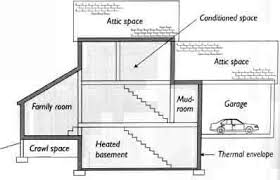I was just cleaning the house this week, you know, the usual… picking things up to dust and sweep around them. It’s the never ending chore of being a homeowner but it got me thinking. Where the heck does all this dust come from in the middle of summer when my windows and doors have been shut around the clock so I don’t waste all that cool and refreshing conditioned air? I just cleaned maybe a week ago, possibly two but still… there is no explanation for all this dust to return. Maybe I should ask the neighbors if they have seen any suspicious individuals around the house with a bag of dust, or maybe the tooth fairy has a not-so-well liked distant cousin, “the dust fairy”. But for real, what could it be?
It could be that the atmosphere around your home is dusty and a little bit of dust enters into the home each time you open the door. If that’s the novel you want to write to cope with the constant amount of dust in your home then to each their own, but the more likely cause of dust inside your home is duct leakage and thermal envelope leakage which increases air infiltration. This is especially true when all the doors and windows are closed pretty much 24/7 during the peak summer and winter months. Lets break it down.
Duct Leakage
The average duct leakage in a home is anywhere from 20-30%, you personally might be lower or you could be higher but that is the average. Another heavy number to swallow, just 1 square inch of duct leakage has the same impact as a 30 square inch hole on an exterior wall. I know that seems drastic being 30 times the number but the duct work is under additional pressure with the blower fan and that is why it becomes a big deal. For visual, this is the same as opening a 30 inch window just 1 inch and leaving it open all day even with the AC or heat on. Pretty crazy right? While many homeowners or the general public may be quick to relate duct leakage to energy savings, you wouldn’t be wrong, but by no means forget that leaky ducts also mean more opportunity to pull stuff in from those leaks. The duct work might be out of sight and behind your interior walls, for the most part, but I can assure you that it’s hanging out right next to some stuff you don’t want to have inside of your home or lungs; dirt, dust, insulation fibers (fiberglass), mildew, humidity, etc. For this topic we are only concerned about the dust, which many times is a combination of the aforementioned air pollutants. There are different tests that can be used to calculate duct leakage or airflow loss, just be sure to ask when scheduling someone to come to your home.

Thermal Envelope Leakage
To understand this, if you aren’t familiar, lets first define what I mean here. The thermal envelope that I am referring to is made up of the walls, floors, ceiling, windows, doors, etc. which separate your indoor living space from the outside. An easier way to put this is the area in which conditioned air is meant to be and not where it isn’t. Therefore you’re attic, crawlspace and garage are outside of this envelope, and depending on where you choose to have conditioned air or the age of the home, a basement may also be outside this envelope. The home needs to breathe, naturally through leakage or the better alternative is through mechanical ventilation. For that reason, I am not stating that all the holes in this envelope need to be sealed unless you have a plan of action to provide an adequate amount of air back into the space. If the building is too tight and you aren’t bringing in fresh air through some source then you’ll have more problems than it’s worth.
Leaks in the envelope can be a pain to find with a smoke puffer or other instrument and an even greater pain to seal after you reach certain stages in the build process. Some common areas are around interior outlets that are in place on an exterior wall, plumbing penetrations, casing around windows and doors, can lights fixtures, and anywhere else that there is a break in the drywall to allow an opportunity for infiltration. For context, 3.0 ACH (or air changes per hour) is a number that is lower than many states do not hold their new home builds to. What does that mean? 3 air changes an hour is the same as saying 3 times an hour then entire volume of air in a home is being completely turned over with brand new air through leaks in the home allowing air in or by means of mechanical ventilation which controls the air exchange. All those small leaks don’t seem like much on their own but to be able to turn over the air in a 2,000+ square foot home at least once every 20 minutes, even when all the doors and windows are closed is pretty amazing to me. That’s a whole lot of dust build up opportunity. You can have your home easily tested with a blower door, just make sure to ask the next time you speak with your local HVAC contractor.
Long story short, the combination of duct leakage and thermal envelope air infiltration are huge factors in why a home gets as dusty as it gets. Less leakage equals less dust which means more time for you to focus on other things around the house or in your life. Any amount of sealing you can get done will certainly be a huge improvement that won’t go unnoticed.

Some common signs of duct or building envelope leakage (Under Normal Home Circumstances):
- Air Filter is dirty prior to the recommended 3 months*
- Higher Efficiency filters will likely need to be changed earlier than 3 months regardless as their intent is to filter very, very tiny particles and thus, they get dirtier, faster.
- Visible dust build up inside your duct work
- Visible dust around return grilles
- Temperature variances from room to room on the same floor
- This is typically noticeable in the room(s) further away from the central system
- Temperature variances from one floor to another floor (Second floor never cooling off like the first floor)
- Visually seeing a random draft or feeling air coming from exposed duct work where it should not be.
- Visually seeing the leak(s)
Dont get me wrong, I am not claiming that all dust comes from infiltration and leakage. If you just had a big project at the house that involved dust from things like lumber, tile, drywall inside the home and you forgot to either turn off the HVAC system or cover the returns then sure, your filter is going to dirty up faster than expected, or your duct work may have a layer of dust inside it. Depending on your line of work you may also be more likely to bring dirt/dust into your home either on your clothing or on your skin. Not all of the dust build up in your home is going to be from natural air infiltration BUT, a good majority of it will be. Tightening up your home to remove these leakage points will not only decrease the pain point of dust in the home but can significantly improve your health with better IAQ.
One final thought, DUST… maybe it stands for Dont U Seal This, referring to the leaks in your home. The dust knows how to get into your home, now you know how to stop it!
